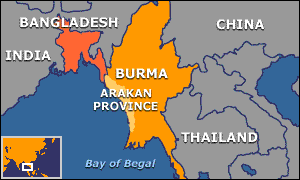In 1826, Burma lost the First Anglo-Burmese War to the British who were ruling India.
MAP: Burma and Bangladesh (previously a part of India) are neighbouring countries
Having lost the war, King Bagyidaw of Burma was forced to sign the Treaty of Yandabo with the British victors. Under the terms of the treaty, Burma had to cede Arakan and other lands to the British.
MAP: Rakhine state (Arakan) in Burma today is contiguous with Bangladesh
Loss of national sovereignty when Burma was absorbed into India
The ceding of Arakan and other territories marked the beginning of British rule in Burma.
By 1885, Britain had conquered Burma and deposed her king. As a consequence of the Third Anglo-Burmese War, Burma not only became a part of the British Empire but more humiliatingly, was made a province of India under the rule of the British Raj.
The first commissioner of the “province” of British Burma in 1862 was Lieutenant-Colonel Sir Arthur Purves Phayre who later in 1883 published his book, History of Burma.
MAP: Chittagong in present-day Bangladesh borders Rakhine/Arakan in Burma (Note: Bangladesh was only created as a modern country in 1971)
British imperialism messed up Burma’s demography
A.P. Phayre recorded that thousands of coolies emigrated from the Chittagong district in the 1830s to work in Arakan. Chittagong is located in the Bengal region and its people are called Bengali.
Over the next few decades, the British encouraged a massive immigration of Bengali Muslim labourers into Arakan until the Muslim population (called “Chittagonian” then, Rohingya today) were almost the same number as the Arakanese natives.
Essentially, the British did the same to Burma as they did to Malaya.
In Malaya, the British brought in Indian labourers as well as allowed Chinese mass migration until the Malays were no longer the dominant race. In Burma, the British brought in Indian (Bengali) labourers to the point that the native Buddhist Rakhine were no longer the dominant race in some areas of Arakan.
Impact of British colonial economy and policies on the natives
In the 1921 census of Burma, Muslims were listed as “Mahomedan” at the same time Bengalis were listed as “Indians” and with some overlap in the categories.
There was resentment of the Indian Muslim immigrants by the locals and anti-Indian riots broke out in Burma during the colonial period.
Burma and Malaya share another historical parallel in the bloodshed that occurred during World War Two resulting from ethnic conflict. In Malaya, Sino-Malay clashes broke out in late 1945 and early 1946 during the brief period called interregnum, i.e. after the Japanese surrendered and before British troops returned to Malaya.
In Arakan Burma, communal violence between Arakanese Buddhists and Muslim Chittagonians erupted in 1942-1943 – a short period of anarchy between the evacuation by the British from the area and the occupation by Japanese troops.
Burma achieved independence from British rule in January 1948. Unlike Malaya that granted Chinese and Indians citizenship, Burma did not grant citizenship to the Bengalis.
BELOW: “The British empire subjugated people across the world, including here in Burma in 1887″
Destructive legacy of British empire in their former colonies
The British had brought masses of Indian labourers into Malaya and today, the poor among this Indian community – particularly the DEWs (Displaced Estate Workers) – are marginalized Hindus in a Muslim country, with some left stateless.
The British brought masses of Indian labourers into Burma and today, this Bengali community in Arakan/Rakhine are marginalized Muslims in a Buddhist country, with many left stateless.
(after Helen ANg)
(after Helen ANg)





No comments:
Post a Comment